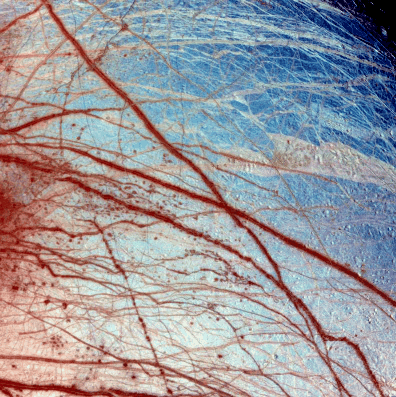The Cracked Ice Plains of Europa

Explanation:
What caused the cracks in this giant ice-ball?
Jupiter's moon
Europa
has smoothest surface in the solar system and is composed mostly
of cracked water-ice. In the
above false-colored picture
released last week by the
NASA team
in charge of the
Galileo
mission,
blue hues represent ice plains divided by dirty red and brown
bands of mottled terrain. As the robot Galileo spacecraft orbits
Jupiter, it sends back revealing pictures of Jupiter and
its
large moons
including
Europa,
Io,
Ganymede, and
Callisto.
The region of
Europa
highlighted above is known as Minos Linea. The cause for many
of the cracks remains unknown but
may involve shifting stresses
from gravity and temperature variations. The new Galileo pictures
have increased evidence that
liquid oceans may indeed exist
under these giant ice-sheets, a
place possibly ripe for the development of life.
Authors & editors:
Robert Nemiroff
(MTU) &
Jerry Bonnell
(USRA)
NASA Web Site Statements, Warnings,
and Disclaimers
NASA Official: Jay Norris.
Specific
rights apply.
A service of:
LHEA at
NASA /
GSFC
& Michigan Tech. U.

